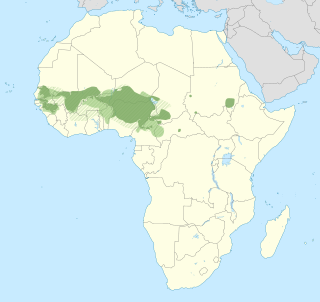
Concepts are defined as abstract ideas. They are understood to be the fundamental building blocks of the concept behind principles, thoughts and beliefs. They play an important role in all aspects of cognition. As such, concepts are studied by several disciplines, such as linguistics, psychology, and philosophy, and these disciplines are interested in the logical and psychological structure of concepts, and how they are put together to form thoughts and sentences. The study of concepts has served as an important flagship of an emerging interdisciplinary approach called cognitive science.
A morpheme is the smallest meaningful constituent of a linguistic expression. The field of linguistic study dedicated to morphemes is called morphology.
In linguistics, a noun class is a particular category of nouns. A noun may belong to a given class because of the characteristic features of its referent, such as gender, animacy, shape, but such designations are often clearly conventional. Some authors use the term "grammatical gender" as a synonym of "noun class", but others consider these different concepts. Noun classes should not be confused with noun classifiers.
A noun is a word that generally functions as the name of a specific object or set of objects, such as living creatures, places, actions, qualities, states of existence, or ideas.
An adjective is a word that describes a noun or noun phrase. Its semantic role is to change information given by the noun.
In grammar, a part of speech or part-of-speech is a category of words that have similar grammatical properties. Words that are assigned to the same part of speech generally display similar syntactic behavior, sometimes similar morphological behavior in that they undergo inflection for similar properties and even similar semantic behavior. Commonly listed English parts of speech are noun, verb, adjective, adverb, pronoun, preposition, conjunction, interjection, numeral, article, and determiner.

The modern Chinese varieties make frequent use of what are called classifiers or measure words. One use of classifiers is when a noun is qualified by a numeral known as a noun phrase. When a phrase such as "one person" or "three books" is translated into Chinese, it is normally necessary to insert an appropriate classifier between the numeral and the noun. For example, in Standard Mandarin, the first of these phrases would be 一个人 yí gè rén, where yī means "one", rén means "person", and gè is the required classifier. There are also other grammatical contexts in which classifiers are used, including after the demonstratives 这 (這) zhè ("this") and 那 nà ("that"); however, when a noun stands alone without any such qualifier, no classifier is needed. There are also various other uses of classifiers: for example, when placed after a noun rather than before it, or when repeated, a classifier signifies a plural or indefinite quantity.
Higher order grammar (HOG) is a grammar theory based on higher-order logic. It can be viewed simultaneously as generative-enumerative or model theoretic.
A classifier is a word or affix that accompanies nouns and can be considered to "classify" a noun depending on the type of its referent. It is also sometimes called a measure word or counter word. Classifiers play an important role in certain languages, especially East Asian languages, including Chinese, Korean, Japanese, and Vietnamese. Classifiers are absent or marginal in European languages. An example of a possible classifier in English is piece in phrases like "three pieces of paper".

Fula, also known as Fulani or Fulah, is a Senegambian language spoken by around 25 million people as a set of various dialects in a continuum that stretches across some 18 countries in West and Central Africa. Along with other related languages such as Serer and Wolof, it belongs to the Atlantic geographic group within Niger–Congo, and more specifically to the Senegambian branch. Unlike most Niger-Congo languages, Fula does not have tones.
In linguistics, a feature is any characteristic used to classify a phoneme or word. These are often binary or unary conditions which act as constraints in various forms of linguistic analysis.
Semantic dementia (SD), also known as semantic variant primary progressive aphasia (svPPA), is a progressive neurodegenerative disorder characterized by loss of semantic memory in both the verbal and non-verbal domains. However, the most common presenting symptoms are in the verbal domain. Semantic dementia is a disorder of semantic memory that causes patients to lose the ability to match words or images to their meanings. However, it is fairly rare for patients with semantic dementia to develop category specific impairments, though there have been documented cases of it occurring. Typically, a more generalized semantic impairment results from dimmed semantic representations in the brain.
A determinative, also known as a taxogram or semagram, is an ideogram used to mark semantic categories of words in logographic scripts which helps to disambiguate interpretation. They have no direct counterpart in spoken language, though they may derive historically from glyphs for real words, and functionally they resemble classifiers in East Asian and sign languages. For example, Egyptian hieroglyphic determinatives include symbols for divinities, people, parts of the body, animals, plants, and books/abstract ideas, which helped in reading, but none of which were pronounced.
The lexical decision task (LDT) is a procedure used in many psychology and psycholinguistics experiments. The basic procedure involves measuring how quickly people classify stimuli as words or nonwords.
Paumarí is an Arauan language spoken in Brazil by about 300 older adults out of an ethnic population of 900. It is spoken by the Paumari Indians, who call their language “Pamoari”. The word “Pamoari” has several different meanings in the Paumarí language: ‘man,’ ‘people,’ ‘human being,’ and ‘client.’ These multiple meanings stem from their different relationships with outsiders; presumably it means ‘human being’ when they refer to themselves to someone of ostensibly equal status, and ‘client’ when referring to their people among river traders and Portuguese speakers.
Deverbal nouns are nouns that are derived from verbs or verb phrases. The formation of deverbal nouns is a type of nominalization. Examples of deverbal nouns in English include organization, the noun construct, discovery, and opening from the verb open.
In linguistics, the term nominal refers to a category used to group together nouns and adjectives based on shared properties. The motivation for nominal grouping is that in many languages nouns and adjectives share a number of morphological and syntactic properties. The systems used in such languages to show agreement can be classified broadly as gender systems, noun class systems or case marking, classifier systems, and mixed systems. Typically an affix related to the noun appears attached to the other parts of speech within a sentence to create agreement. Such morphological agreement usually occurs in parts within the noun phrase, such as determiners and adjectives. Languages with overt nominal agreement vary in how and to what extent agreement is required.
Music semantics refers to the ability of music to convey semantic meaning. Semantics are a key feature of language, and whether music shares some of the same ability to prime and convey meaning has been the subject of recent study.
Kadu or Kado is a Sino-Tibetan language of the Sal branch spoken in Sagaing Region, Myanmar. Dialects are Settaw, Mawkhwin, and Mawteik [extinct], with 30,000 speakers total.

English adjectives form a large open category of words in English which, semantically, tend to denote properties such as size, colour, mood, quality, age, etc. with such members as other, big, new, good, different, Cuban, sure, important, and right. Adjectives head adjective phrases, and the most typical members function as modifiers in noun phrases. Most adjectives either inflect for grade or combine with more and most to form comparatives and superlatives. They are characteristically modifiable by very. A large number of the most typical members combine with the suffix -ly to form adverbs. Most adjectives function as complements in verb phrases, and some license complements of their own.



